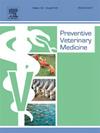Pathology of new world camelids in Ireland: 13 years of disease surveillance and the significance of bovine tuberculosis in alpaca
IF 2.2
2区 农林科学
Q1 VETERINARY SCIENCES
引用次数: 0
Abstract
Causes of New World Camelid (168 alpacas; 7 llamas) mortality in Ireland based on review of passive surveillance findings of the Irish Veterinary Laboratory Service from 2010 till 2023 were analysed. The most frequently submitted age group were adults (58.8 %), followed by juveniles (20.6 %), crias (16.6 %), and aborted foeti (4 %). Regardless of age, 96 % were suitable for investigation, with identified aetiology in 77.4 % of cases. The pathology was systemic (30.9 %) or involving the alimentary (39.3 %), respiratory (8.9 %), urogenital (4.9 %), musculoskeletal and lymphatic (2.2 % each), integument (1.8 %), cardiocirculatory (1.3 %), nervous (0.9 %) system; 7.6 % were inconclusive. The aetiology was bacterial (44.4 %), parasitic (24.3 %), nutritional/metabolic/toxic (6.4 %), traumatic/mechanical (3.2 %), congenital (1.6 %), and neoplastic (0.5 %), while 19.6 % had unknown aetiology. The diagnostic rate was highest in crias (79.3 %) and lowest in the abortion group (0 %). Crias had mainly systemic and alimentary tract diseases (43.3 % and 26.6 %, respectively); juveniles had mainly alimentary illness and systemic diseases (51.3 % and 30.7 %, respectively); similarly for adults (40.2 % and 25.5 %, respectively). The primary aetiology detected was bacterial (45.5 %, 35.1 %, and 48.7 % for crias, juveniles and adults, respectively). Mycobacterium bovis was identified in 27.4 % of submissions, 25 % of which had lesions localised to a single organ (mainly lung), whilst 75 % had generalised tuberculosis, where the lung and liver were the most and second most commonly affected organs, respectively. Fasciola hepatica infection represented the second most common cause or co-cause of mortality. To the authors' knowledge, this is the most extensive published case series of M. bovis pathology in alpacas.
爱尔兰新大陆骆驼的病理学:13年的疾病监测和羊驼牛结核病的意义
新世界骆驼群成因(168头羊驼;根据对2010年至2023年爱尔兰兽医实验室服务被动监测结果的审查,分析了爱尔兰7只大羊驼的死亡率。最常提交的年龄组是成年人(58.8% %),其次是青少年(20.6% %),crias(16.6% %)和流产胎儿(4% %)。无论年龄大小,96 %适合调查,77.4% %的病例病因明确。病理表现为系统(30.9 %)或涉及消化系统(39.3 %)、呼吸系统(8.9 %)、泌尿生殖系统(4.9 %)、肌肉骨骼和淋巴系统(各2.2 %)、被膜系统(1.8 %)、心血管系统(1.3 %)、神经系统(0.9 %);7.6% %不确定。病因为细菌性(44.4% %)、寄生性(24.3% %)、营养/代谢/毒性(6.4 %)、外伤性/机械性(3.2 %)、先天性(1.6 %)、肿瘤性(0.5 %),病因不明的占19.6 %。crias组诊断率最高(79.3% %),流产组诊断率最低(0 %)。Crias主要为系统和消化道疾病(分别为43.3% %和26.6% %);青少年主要有消化道疾病和全身性疾病(分别为51.3% %和30.7% %);成年人也是如此(分别为40.2% %和25.5% %)。主要病原为细菌(crias、幼鱼和成虫分别为45.5% %、35.1% %和48.7% %)。在27.4% %的提交病例中发现了牛分枝杆菌,其中25% %的病变局限于单一器官(主要是肺),而75% %的患者患有广发性结核病,其中肺和肝脏分别是最常见和第二常见的受影响器官。肝片形吸虫感染是死亡的第二大常见原因或共同原因。据作者所知,这是羊驼中最广泛发表的牛分枝杆菌病理病例系列。
本文章由计算机程序翻译,如有差异,请以英文原文为准。
求助全文
约1分钟内获得全文
求助全文
来源期刊

Preventive veterinary medicine
农林科学-兽医学
CiteScore
5.60
自引率
7.70%
发文量
184
审稿时长
3 months
期刊介绍:
Preventive Veterinary Medicine is one of the leading international resources for scientific reports on animal health programs and preventive veterinary medicine. The journal follows the guidelines for standardizing and strengthening the reporting of biomedical research which are available from the CONSORT, MOOSE, PRISMA, REFLECT, STARD, and STROBE statements. The journal focuses on:
Epidemiology of health events relevant to domestic and wild animals;
Economic impacts of epidemic and endemic animal and zoonotic diseases;
Latest methods and approaches in veterinary epidemiology;
Disease and infection control or eradication measures;
The "One Health" concept and the relationships between veterinary medicine, human health, animal-production systems, and the environment;
Development of new techniques in surveillance systems and diagnosis;
Evaluation and control of diseases in animal populations.
 求助内容:
求助内容: 应助结果提醒方式:
应助结果提醒方式:


